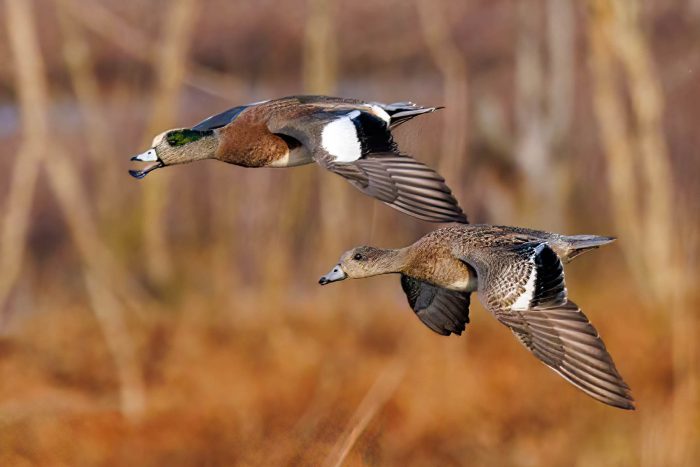American Wigeon
Mareca americana
Wintering in the Bay, American wigeons are known for the green stripe and white spot on the heads of males.
This section shows one large critter image at a time. Use the thumbnails that follow to select a specific image to display here.

This gallery contains a grid of small thumbnails. Selecting a thumbnail will change the main image in the preceding section.
Appearance
Breeding males have a mostly brown head with an iridescent green stripe behind their eye and a white cap on the top of their head that gives them the nickname “bald pate”. Females have a light brown body with a series of wavy, brown and white feathers on their head. Both males and females have a blueish-black tipped bill.
Feeding
American wigeons mainly feed by dipping their bill into the water to pluck out insects and grass. They will also feed in fields as they use their short, goose-like bill to rip up vegetation.
Predators
Eggs and ducklings are preyed upon by mammals and birds such as foxes, raccoons, skunks, hawks and crows.
Flight
You can find American wigeons migrating in flocks, traveling mostly by day. When flying, the duck reveals the white underside of its wings.
Reproduction and life cycle
American wigeons breed up north before migrating to the Chesapeake Bay area to overwinter. They build their nests near ponds and lakes. The female lays a single clutch of three to 13 eggs. Females incubate the eggs for around 24 days and the males depart before the eggs hatch. Young are quick to leave the nest and will feed themselves. Young capable of flight 45-63 days after hatching.
Did you know?
American wigeons nest farther north than any other dabbling duck with the exception of the northern pintail.
American wigeons are often called “bald pates” for the white forehead and crown that gives the male the look of a bald man.
American wigeons are one of the first ducks to leave the Chesapeake Bay in the spring.
Sources and additional information
American wigeon - Ducks Unlimited
American wigeon remind us to look for joy, even in storms - Bay Journal
American wigeon - U.S. Fish & Wildlife Service
American wigeon - The Cornell Lab
